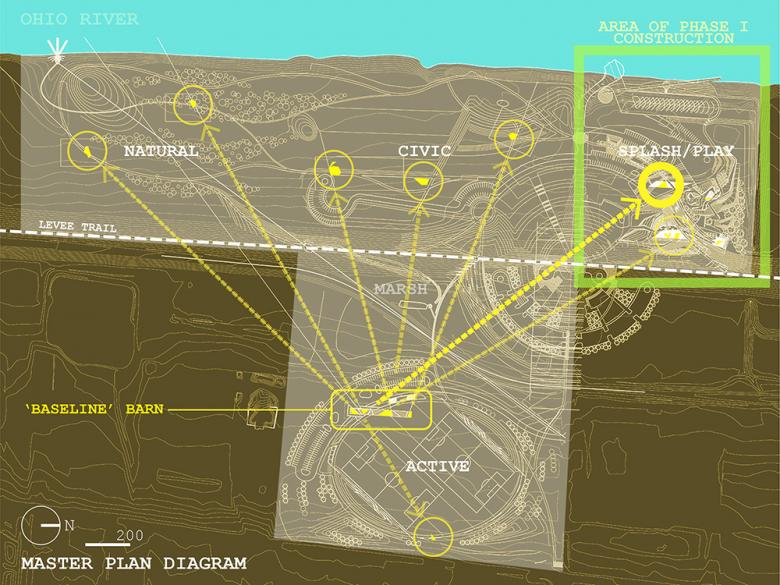Riverview Park Visitor Service Building I
Riverview Park Visitor Service Building I
29. April 2013
Located on the banks of the Ohio River southwest of downtown Louisville, Riverbank Park is 70 acres envisioned by De Leon & Primmer Architecture Workshop in their master plan "as a new recreational venue for the community." The first component in the park's master plan is a building that houses restrooms and drinking fountains behind walls alternately rusty and translucent. The building makes a statement in the landscape and is a sign of things to come. The architects answered some questions about the project.
View from west
What were the circumstances of receiving the commission for this project?
D&PAW was selected by the Waterfront Development Corporation for our prior experience with public park projects.
Evening view
Can you describe your design process for the building?
We immersed ourselves into the physical, historical and cultural context of the site, and often worked in the immediacy of the riverside landscape with our laptops and a card table.
The building is a prototype and part of a series of future structures within the park master plan that will share similar characteristics. It was important for us to reinforce a cohesive visitor experience between the diverse activity zones of the park through variations in orientation, geometry, and detailing. The design is greatly influenced by the agrarian and river transportation history of the site, particularly the recognizable imagery of regional tobacco barns and river barges that are frequently visible from the park. It is this playful interpretation of barn & barge precedents that led us to developing park structures that would be both familiar and new.
At the same time, we were mindful of challenges that were unique to this project: a site that is within a flood plain, a highly public program prone to vandalism and graffiti, the importance of visitor safety and security monitoring, and issues of building maintenance. We explored materials and building systems that were common, ordinary and off-the-shelf, and reconsidered their potential to achieve something quite unconventional.
Detail of Cor-ten steel louver wall
How does the completed building compare to the project as designed? Were there any dramatic changes between the two and/or lessons learned during construction?
The prototype building closely matches the original concept. We worked hand-in-hand with the construction & fabrication team to ensure that the design intent would be accurately translated. Early on in the design process, we were already thinking at the detail level while still exploring massing and form, building full scale mockups to explore the challenges and limitations of specific materials.
Floor Plan / Roof Plan
How does the building relate to contemporary architectural trends, be it sustainability, technology, etc.?
The building takes our interests in passive sustainable strategies a step further, looking at how simply we can design through a nuanced understanding of site and climate. Rather than employing the ‘usual suspects’ of green industry products (green roofs, solar panels, geothermal, etc.), our approach was reductive and instead asked how little we could use. For example, this building has no heating or cooling, taking advantage of constant breezes by its proximity to the river through the porosity of the building skin. The prefabricated nature of its material components virtually eliminates onsite construction waste, and its durability minimizes on-going building maintenance. All of the steel was sourced and fabricated nearby just across the Ohio river.
Master Plan and Area of Phase 1 Construction
Are there any new/upcoming projects in your office that this building’s design and construction has influenced?
We are constantly intrigued by the potential of conventional materials. This project was an opportunity to explore complexity in the building envelope through a rather simple method of fabrication and erection. We pushed this a bit further with the Wild Turkey Bourbon Visitor Center, currently under construction and opening in late June 2013, which has an intricate filigree of stained wood cladding – a kind of "building plumage."
Diagram of Phase 1 Building Form Derivation
How would you describe the architecture of Kentucky and how does the building relate to it?
Kentucky has a rich agrarian building tradition, and this project continues a series of explorations on the black-pitched tobacco barn typology which is common to our region. In this particular instance, we were concerned with issues of form and materiality within the highly public context of a civic park, as well responding to the vulnerabilities of a flood-prone site.
Email interview conducted by John Hill.
Email interview conducted by John Hill.
Riverview Park Visitor Service Building I
2011
Louisville, Kentucky
Client
Waterfront Development Corporation
Architect
De Leon & Primmer Architecture Workshop
Louisville, KY
Design Principal
Roberto de Leon, M. Ross Primmer
Structural Engineer
Sentry Steel (Design/Build)
Contractor
T&C Contracting, Cambridge Construction
Construction Manager
Steven Lund
Steel Fabricator
Sentry Steel
Site Area
11 acres (Phase 1)/70 acres (Master Plan)
Built Area
505 sf
Photographs & Drawings
De Leon & Primmer Architecture Workshop
Louisville, KY
Design Principal
Roberto de Leon, M. Ross Primmer
Structural Engineer
Sentry Steel (Design/Build)
Contractor
T&C Contracting, Cambridge Construction
Construction Manager
Steven Lund
Steel Fabricator
Sentry Steel
Site Area
11 acres (Phase 1)/70 acres (Master Plan)
Built Area
505 sf
Photographs & Drawings
De Leon & Primmer Architecture Workshop
Related articles
-
Spotlight on Italy
on 5/16/18
-
Bologna Shoah Memorial
on 7/20/15





